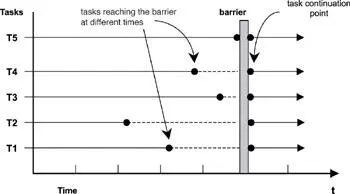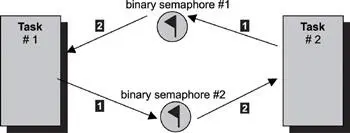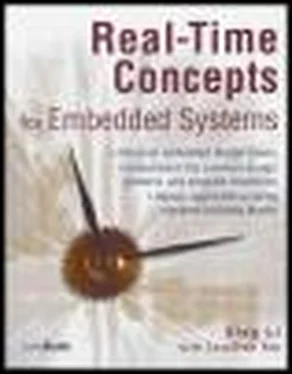While this model simplifies resource synchronization, the resource server is a bottleneck. Synchronization primitives, such as semaphores and mutexes, and other methods introduced in a later section of this chapter, allow developers to implement complex mutual exclusion algorithms. These algorithms in turn allow dynamic coordination among competing tasks without intervention from a third party.
15.2.2 Activity Synchronization
In general, a task must synchronize its activity with other tasks to execute a multithreaded program properly. Activity synchronization is also called condition synchronization or sequence control. Activity synchronization ensures that the correct execution order among cooperating tasks is used. Activity synchronization can be either synchronous or asynchronous.
One representative of activity synchronization methods is barrier synchronization. For example, in embedded control systems, a complex computation can be divided and distributed among multiple tasks. Some parts of this complex computation are I/O bound, other parts are CPU intensive, and still others are mainly floating-point operations that rely heavily on specialized floating-point coprocessor hardware. These partial results must be collected from the various tasks for the final calculation. The result determines what other partial computations each task is to perform next.
The point at which the partial results are collected and the duration of the final computation is a barrier. One task can finish its partial computation before other tasks complete theirs, but this task must wait for all other tasks to complete their computations before the task can continue.
Barrier synchronization comprises three actions:
· a task posts its arrival at the barrier,
· the task waits for other participating tasks to reach the barrier, and
· the task receives notification to proceed beyond the barrier.
A later section of this chapter shows how to implement barrier synchronization using mutex locks and condition variables.
As shown in Figure 15.2, a group of five tasks participates in barrier synchronization. Tasks in the group complete their partial execution and reach the barrier at various times; however, each task in the group must wait at the barrier until all other tasks have reached the barrier. The last task to reach the barrier (in this example, task T5) broadcasts a notification to the other tasks. All tasks cross the barrier at the same time (conceptually in a uniprocessor environment due to task scheduling. We say 'conceptually' because in a uniprocessor environment, only one task can execute at any given time. Even though all five tasks have crossed the barrier and may continue execution, the task with the highest priority will execute next.

Figure 15.2: Visualization of barrier synchronization.
Another representative of activity synchronization mechanisms is rendezvous synchronization, which, as its name implies, is an execution point where two tasks meet. The main difference between the barrier and the rendezvous is that the barrier allows activity synchronization among two or more tasks, while rendezvous synchronization is between two tasks.
In rendezvous synchronization, a synchronization and communication point called an entry is constructed as a function call. One task defines its entry and makes it public. Any task with knowledge of this entry can call it as an ordinary function call. The task that defines the entry accepts the call, executes it, and returns the results to the caller. The issuer of the entry call establishes a rendezvous with the task that defined the entry.
Rendezvous synchronization is similar to synchronization using event-registers, which Chapter 8 introduces, in that both are synchronous. The issuer of the entry call is blocked if that call is not yet accepted; similarly, the task that accepts an entry call is blocked when no other task has issued the entry call. Rendezvous differs from event-register in that bidirectional data movement (input parameters and output results) is possible.
A derivative form of rendezvous synchronization, called simple rendezvous in this book, uses kernel primitives, such as semaphores or message queues, instead of the entry call to achieve synchronization. Two tasks can implement a simple rendezvous without data passing by using two binary semaphores, as shown in Figure 15.3.

Figure 15.3: Simple rendezvous without data passing.
Both binary semaphores are initialized to 0. When task #1 reaches the rendezvous, it gives semaphore #2, and then it gets on semaphore #1. When task #2 reaches the rendezvous, it gives semaphore #1, and then it gets on semaphore #2. Task #1 has to wait on semaphore #1 before task #2 arrives, and vice versa, thus achieving rendezvous synchronization.
15.2.3 Implementing Barriers
Barrier synchronization is used for activity synchronization. Listing 15.1 shows how to implement a barrier-synchronization mechanism using a mutex and a condition variable.
Listing 15.1: Pseudo code for barrier synchronization.
typedef struct {
mutex_t br_lock; /* guarding mutex */
cond_t br_cond; /* condition variable */
int br_count; /* num of tasks at the barrier */
int br_n_threads; /* num of tasks participating in the barrier synchronization */
} barrier_t;
barrier(barrier_t *br) {
mutex_lock(&br-›br_lock);
br-›br_count++;
if (br-›br_count ‹ br-›br_n_threads) cond_wait(&br-›br_cond,&br-›br_lock);
else {
br-›br_count = 0;
cond_broadcast(&br-›br_cond);
}
mutex_unlock(&br-›br_lock);
}
Each participating task invokes the function barrier for barrier synchronization. The guarding mutex for br_count and br_n_threads is acquired on line #2. The number of waiting tasks at the barrier is updated on line #3. Line #4 checks to see if all of the participating tasks have reached the barrier.
If more tasks are to arrive, the caller waits at the barrier (the blocking wait on the condition variable at line #5). If the caller is the last task of the group to enter the barrier, this task resets the barrier on line #6 and notifies all other tasks that the barrier synchronization is complete. Broadcasting on the condition variable on line #7 completes the barrier synchronization.
Tasks communicate with one another so that they can pass information to each other and coordinate their activities in a multithreaded embedded application. Communication can be signal-centric, data-centric, or both. In signal-centric communication, all necessary information is conveyed within the event signal itself. In data-centric communication, information is carried within the transferred data. When the two are combined, data transfer accompanies event notification.
When communication involves data flow and is unidirectional, this communication model is called loosely coupled communication. In this model, the data producer does not require a response from the consumer. Figure 15.4 illustrates an example of loosely coupled communication.

Figure 15.4: Loosely coupled ISR-to-task communication using message queues.
Читать дальше















